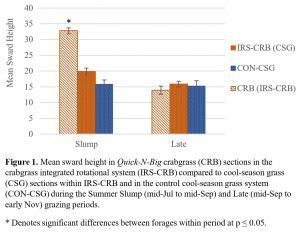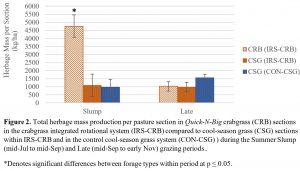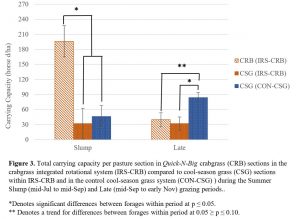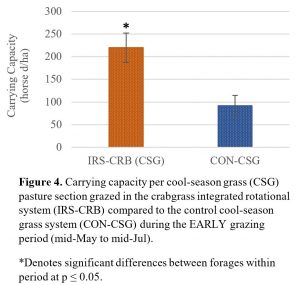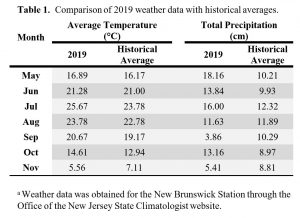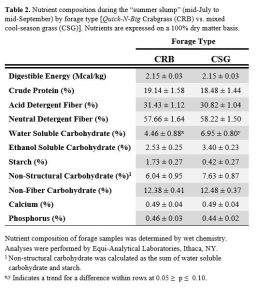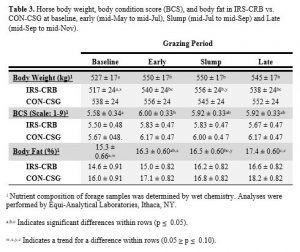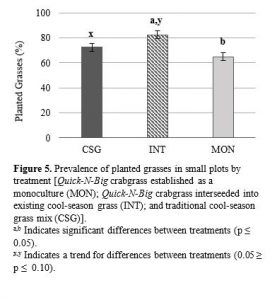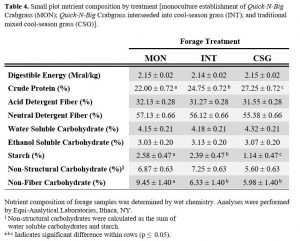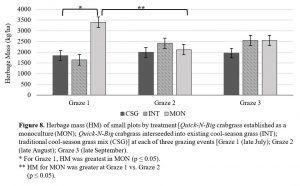Final report for GNE17-162
Project Information
Traditional cool-season grass (CSG) horse pastures in temperate regions of the Northeast United States typically experience low productivity in summer months. The objective of this study was to determine the effectiveness of an integrated warm- and cool-season grass rotational grazing system (IRS) incorporating the warm-season grass (WSG) test forages Wrangler bermudagrass (BER) or Quick-N-Big crabgrass (CRB) in increasing pasture forage yield during the "summer slump", thereby increasing pasture carrying capacity and decreasing producer feed costs. This study also assessed the impact of IRS management on forage nutritive value and horse body condition. Finally, this project evaluated the impact of establishment method (monoculture vs. interseeded) on pasture forage yield.
In 2019, a full-pasture study was conducted in three rotational grazing systems (1. traditional cool-season [CON-CSG], 2. BER integrated into cool-season [IRS-BER], and 3. CRB integrated into cool-season [IRS-CRB]) evaluated under grazing by nine adult Standardbred horses (n=3) over a full grazing season. Each grazing system consisted of six sections. In the IRSs, the WSG test forage was established in monoculture in three of the six sections, with a previously established cool-season grass mix in the remaining three sections. Productivity was assessed by measuring pasture sward height (SH) and herbage mass (HM) prior to each rotation, and carrying capacity (CC) was determined based upon grazing days per pasture section. Pasture forage nutritional composition was analyzed in hand-clipped samples also collected prior to each rotation. Costs of establishing and maintaining pasture systems were tracked along with supplemental hay expenses. Horse body weight (BW), body condition score (BCS), and body fat (FAT) were assessed monthly.
Differences in SH and HM between monoculture establishment and interseeding of WSG test forages was evaluated in a small plot study using a randomized complete block design. Two main plots each containing four replicates of three treatments (CSG, MON (either CRB or BER in monoculture), and INT (either CRB or BER interseeded) for a total of 12 sub-plots per main plot were established. Horses in each IRS (3) grazed each main plot for one 8-hr grazing event (2 d of grazing, 1 d per main plot). Horses had access to all replicates within the main plot during the grazing event. Grazing events were repeated 3 times across the grazing season.
Summer re-growth of BER previously established in the full pasture sections was poor and winter-kill was extensive. Subsequent re-seeding of BER sections (2019) also resulted in inadequate establishment, and due to the delay in establishment, only one grazing rotation was possible in two of the three BER sections prior to the onset of cooler temperatures at the end of the BER growing season window. The establishment was similarly poor in the BER small plots. Thus, it was not possible to complete a full evaluation of the IRS-BER system.
In the full pasture study of IRS-CRB vs. CON-CSG, grazing began on May 17, 2019. For IRS-CRB, horses were removed from pasture for the final time on October 25, 2019. Horses in CON-CSG were removed from pasture on November 9, 2019. The IRS system supported horses on pasture for 69% of the grazing season, while the CON-CSG allowed grazing for 59% of the season. Horses in both systems had access to CSG pasture sections from mid-May to mid-Jul (EARLY grazing), with no differences in yield measures or CC. Mean SH during the “summer slump” (SLUMP = mid-Jul to mid-Sep) was greater in CRB sections (35.63 ± 5.81 cm) of IRS-CRB than in the CSG sections within that grazing system (15.92 ± 5.81 cm or in the CON-CSG system (13.12 ± 5.81 cm; p ≤ 0.05). Total HM on-offer (available to be grazed) produced in each section during the SLUMP period was greater in CRB (4,758 ± 698 kg/ha) than CSG sections within IRS-CRB (1086 ± 698 kg/ha) or in CON-CSG (970 ± 698 kg/ha; p ≤ 0.05). Mean CC per pasture section was greater for CRB (196.0 ± 31.0 horse d/ha) than for CSG sections within IRS-CRB (32.0 ± 31.0 horse d/ha) or in CON-CSG (46.0 ± 21.9 horse d/ha; p ≤ 0.05). Following the “summer slump” during the LATE grazing period (mid-Sep through Nov 9), however, CC was lower in CSG sections within IRS-CRB (32.0 ± 13.3 horse d/ha; p ≤ 0.05) and CRB sections within IRS-CRB (40.0 ± 13.3 horse d/ha) than in CON-CSG (CSG) sections (84.0 ± 9.4 horse d/ha). The final cost to maintain horses in IRS-CRB was $441/horse. In CON-CSG, this final cost was $488/horse.There was a trend for greater water soluble carbohydrate content in CRB compared to CSG during the SLUMP period. However, no other nutrients differed between forage types within the “summer slump.” Similarly, horse BW, BCS, and FAT did not vary by grazing system (INT-CRB: 538 ± 24 kg, 5.74 ± 0.46, 15.6 ± 0.76 %; CON-CSG: 548 ± 24 kg, 6.05 ± 0.46, 17.0 ± 0.76 %). Horse BW and FAT did differ across grazing periods (p ≤ 0.05), and there was a trend for a period difference in BCS (p ≤ 0.10).
In the small plot study, SH was greatest in MON plots (29.16 ± 0.59 cm), intermediate for INT plots (23.85 ± 0.59 cm) and lowest in plots established with CSG (20.11 ± 0.59 cm; p ≤ 0.05). In addition, HM also differed by treatment, as HM of MON plots (2,714 ± 122 kg/ha) was greater than that of INT (2,139 ± 122 kg/ha; p ≤ 0.05), but HM did not differ between INT and CSG (1,988 ± 122 kg/ha). These differences were primarily attributable to the first grazing event in late July, where yield in MON (3,396 ± 245 kg/ha) exceeded that of either INT (1,644 ± 245 kg/ha) or CSG (1,844 ± 245 kg/ha; p ≤ 0.05).
This study demonstrated that implementing an IRS approach that incorporates the warm-season annual Quick-N-Big crabgrass offers production advantages when compared to a traditional CSG rotational grazing system. Production variables including herbage mass, sward height, and carrying capacity were all greater in crabgrass vs. cool-season pasture sections during the critical “summer slump” period from mid-Jul to mid-Sep. Establishment method also impacted “summer slump” forage production, with monoculture establishment of Quick-N-Big resulting in greater herbage mass and sward height when compared to interseeding into existing cool-season grasses. The integrated rotational grazing approach did not result in marked differences in forage nutritional composition or horse condition in comparison to the traditional cool-season control, and the integrated grazing approach provided adequate nutrition for adult healthy horses.
Thus, this study supports recommendation of a CRB-based IRS strategy as a equine grazing best-management practice in the Northeast U.S. However, further research is necessary to determine the areal proportions of cool-season grass and crabgrass within an integrated system that would optimize full-season pasture production. Additionally, a full-season analysis of monoculture vs. interseeded establishment would provide greater insight regarding the effect of establishment method on early- and late-season pasture production. Conversely, based upon the difficulties in establishing BER, the Wrangler variety may not represent a viable or reliable warm-season pasture grass option for inclusion in integrated pasture systems in the Northeast U.S. Further investigation would also be needed to evaluate alternative turf or sprigged forage bermudagrass varieties in order to determine if a perennial WSG option exists for IRS grazing management in this region.
Objective 1. To determine if warm-season grasses will increase forage availability during summer months when compared to a traditional cool-season system.
Objective 2. To determine the most productive and economically advantageous method of establishment (monoculture or interseeded) for the two warm-season test forages in horse pastures.
Objective 3. To determine if sequential grazing in integrated cool- and warm-season pastures provides adequate nutrition to maintain optimal horse body condition.
Objective 4. To determine if any advantage in production cost exists when integrating either a warm-season annual or perennial into a traditional cool-season horse grazing system.
The purpose of this project is to investigate the potential for increasing pasture productivity, thereby extending the number of grazing days and decreasing producer feed costs through implementation of an integrated cool- and warm-season grass grazing system in horse pastures. Traditional pasture forages in temperate regions of the United States are mainly cool-season perennial grasses. Cool-season grasses are well adapted for survival of cold winters and growth in periods of cooler temperatures in spring, early summer and fall. However, these species are less tolerant of heat and drought, which leads to a period of low forage productivity often called the “summer slump” (Bott et al., 2013; Tracy et al. 2010). Conversely, warm-season grasses produce their greatest yields during the hot summer months while cool-season grasses are semi-dormant (Moore et al., 2004; Tracy et al., 2010). Warm-season grasses, therefore, present an intriguing option for bridging the “summer slump” forage gap.
The “summer slump” presents management challenges to horse producers, with both economic and environmental implications. Supplemental feed is often needed to meet the nutritional needs of horses during the “summer slump,” which increases feed costs during this period. McMeniman (2000) calculated that providing pasture forage reduced feeding costs by as much as 50% when compared to purchased feed. Often, producers will provide supplemental feed to horses in existing pastures. Leaving horses on low productivity pastures can result in overgrazing, leading to negative consequences for the environment. If forage is overgrazed, over time vegetative cover will be reduced. Decreases in vegetative cover increase the potential for soil erosion and nutrient runoff (Butler et al., 2007). Furthermore, overgrazing may result in decreased forage stand persistence and weed invasion. This may necessitate more frequent pasture renovation, conferring additional cost to producers. Alternatively, producers may choose to confine horses to dry lots, allowing the pasture forage time to rest and regrow. . High stocking density increases concentration of manure accumulation and therefore, nitrogen (N) and phosphorus (P), which may result in surface and groundwater contamination. The potential for nutrient runoff from dry lot areas is usually increased due to lack of vegetative filtration (Baxter and Gilliliand, 1988). Furthermore, feeding and excretion areas within horse pastures and paddocks have increased risk of N and P leaching (Parvage et al., 2013). Thus, the “summer slump” negatively impacts economic and environmental sustainability in horse operations.
Developing a grazing system comprised of complementary cool- and warm-season forage varieties would potentially provide more uniform productivity over the grazing season, increasing overall yield and reducing costs associated with supplemental feeding during periods of summer drought. This management strategy is recommended to producers in various industry and extension programs and publications, but little research has been conducted to support the utility of integrated grazing systems for horse producers. Most recommendations are based upon cattle grazing studies. Extrapolating data from studies in other livestock species is often of limited value in management decisions for horse operations. Forage preference, grazing behaviors, nutritional requirements, digestive physiology, animal management goals, and drivers of enterprise profitability are vastly different. While studies in cattle have shown little, if any, economic benefit associated with implementation of integrated cool- and warm- season rotational grazing systems (Moore et al, 2004; Hudson et al, 2010), integrating warm-season grasses into a cool-season pasture system may be better suited to feeding and nutritional goals of horse producers as horses are fed to maintain weight and sustain athletic performance rather than for maximal growth. In fact, over-consumption of cool-season grasses high in non-structural carbohydrates has been linked to many negative health outcomes in horses related to equine metabolic syndrome including obesity, insulin resistance and pasture-associated laminitis (Longland and Byrd, 2006; Frank 2010).
The goal of this project is to determine if two warm-season forage grasses, Quick-N-Big crabgrass and Wrangler bermudagrass, possess utility and economic advantage as alternative summer forages in temperate equine grazing systems. Lack of suitability due to prussic acid production and forage-related disorders associated with many warm-season annuals and cold-sensitivity of traditionally cultivated perennials are limiting factors for integration of warm-season grasses into temperate horse grazing systems. Although native crabgrass traditionally thought of as a weed, Quick-N-Big crabgrass is a high yielding summer annual that is often of higher forage quality than other warm-season grasses (Teutsch et al., 2005). Given the lack of noted forage-related disorders (Teutsch 2009), crabgrass may represent a viable summer forage option for horse pastures. Cold-tolerant bermudagrass varieties such as “Wrangler” are now commonly grown in the transition zone, which corresponds to USDA plant hardiness zones 5 through 7 (Ditsch et al., 2011; Taliaferro 2005). In 2012, the USDA released a new version of the plant hardiness zone map, which was generally warmer by one half zone than the previous version from 1990 (Daly et al., 2012), suggesting that a northward extension of the bermudagrass growing region is possible.
The results of this project will provide much-needed data on forage yield, persistence (vegetative cover), nutritional value, and production costs associated with integration of warm-season grasses into cool-season temperate pastures in the upper transition zone. Discoveries in this area could have real-world impact on horse producers, informing management decisions and shaping best management practices in equine grazing designed to improve economic and environmental sustainability of equine operations. In addition, these results will provide key information for other livestock producers interested in alternative forages.
The purpose of this project is to investigate the potential for increasing pasture productivity, thereby extending the number of grazing days and decreasing producer feed costs through implementation of an integrated cool- and warm-season grass grazing system in horse pastures. Traditional pasture forages in temperate regions of the United States are mainly cool-season perennial grasses. Cool-season grasses are well adapted for survival of cold winters and growth in periods of cooler temperatures in spring, early summer and fall. However, these species are less tolerant of heat and drought, which leads to a period of low forage productivity often called the “summer slump” (Bott et al., 2013; Tracy et al. 2010). Conversely, warm-season grasses produce their greatest yields during the hot summer months while cool-season grasses are semi-dormant (Moore et al., 2004; Tracy et al., 2010). Warm-season grasses, therefore, present an intriguing option for bridging the “summer slump” forage gap.
The “summer slump” presents management challenges to horse producers, with both economic and environmental implications. Supplemental feed is often needed to meet the nutritional needs of horses during the “summer slump,” which increases feed costs during this period. McMeniman (2000) calculated that providing pasture forage reduced feeding costs by as much as 50% when compared to purchased feed. Often, producers will provide supplemental feed to horses in existing pastures. Leaving horses on low productivity pastures can result in overgrazing, leading to negative consequences for the environment. If forage is overgrazed, over time vegetative cover will be reduced. Decreases in vegetative cover increase the potential for soil erosion and nutrient runoff (Butler et al., 2007). Furthermore, overgrazing may result in decreased forage stand persistence and weed invasion. This may necessitate more frequent pasture renovation, conferring additional cost to producers. Alternatively, producers may choose to confine horses to dry lots, allowing the pasture forage time to rest and regrow. . High stocking density increases concentration of manure accumulation and therefore, nitrogen (N) and phosphorus (P), which may result in surface and groundwater contamination. The potential for nutrient runoff from dry lot areas is usually increased due to lack of vegetative filtration (Baxter and Gilliliand, 1988). Furthermore, feeding and excretion areas within horse pastures and paddocks have increased risk of N and P leaching (Parvage et al., 2013). Thus, the “summer slump” negatively impacts economic and environmental sustainability in horse operations.
Developing a grazing system comprised of complementary cool- and warm-season forage varieties would potentially provide more uniform productivity over the grazing season, increasing overall yield and reducing costs associated with supplemental feeding during periods of summer drought. This management strategy is recommended to producers in various industry and extension programs and publications, but little research has been conducted to support the utility of integrated grazing systems for horse producers. Most recommendations are based upon cattle grazing studies. Extrapolating data from studies in other livestock species is often of limited value in management decisions for horse operations. Forage preference, grazing behaviors, nutritional requirements, digestive physiology, animal management goals, and drivers of enterprise profitability are vastly different. While studies in cattle have shown little, if any, economic benefit associated with implementation of integrated cool- and warm- season rotational grazing systems (Moore et al, 2004; Hudson et al, 2010), integrating warm-season grasses into a cool-season pasture system may be better suited to feeding and nutritional goals of horse producers as horses are fed to maintain weight and sustain athletic performance rather than for maximal growth. In fact, over-consumption of cool-season grasses high in non-structural carbohydrates has been linked to many negative health outcomes in horses related to equine metabolic syndrome including obesity, insulin resistance and pasture-associated laminitis (Longland and Byrd, 2006; Frank 2010).
The goal of this project is to determine if two warm-season forage grasses, Quick-N-Big crabgrass and Wrangler bermudagrass, possess utility and economic advantage as alternative summer forages in temperate equine grazing systems. Lack of suitability due to prussic acid production and forage-related disorders associated with many warm-season annuals and cold-sensitivity of traditionally cultivated perennials are limiting factors for integration of warm-season grasses into temperate horse grazing systems. Although native crabgrass traditionally thought of as a weed, Quick-N-Big crabgrass is a high yielding summer annual that is often of higher forage quality than other warm-season grasses (Teutsch et al., 2005). Given the lack of noted forage-related disorders (Teutsch 2009), crabgrass may represent a viable summer forage option for horse pastures. Cold-tolerant bermudagrass varieties such as “Wrangler” are now commonly grown in the transition zone, which corresponds to USDA plant hardiness zones 5 through 7 (Ditsch et al., 2011; Taliaferro 2005). In 2012, the USDA released a new version of the plant hardiness zone map, which was generally warmer by one half zone than the previous version from 1990 (Daly et al., 2012), suggesting that a northward extension of the bermudagrass growing region is possible.
The results of this project will provide much-needed data on forage yield, persistence (vegetative cover), nutritional value, and production costs associated with integration of warm-season grasses into cool-season temperate pastures in the upper transition zone. Discoveries in this area could have real-world impact on horse producers, informing management decisions and shaping best management practices in equine grazing designed to improve economic and environmental sustainability of equine operations. In addition, these results will provide key information for other livestock producers interested in alternative forages.
Research
Full-Pasture Study
General Grazing System: This project was conducted at the Rutgers’ Ryders Lane Best Management Practices Demonstration Horse Farm. Three separate rotational grazing systems, each consisting of 6 sections, were established. System 1 served as a control, and all sections were planted with a cool-season grass mix (CON-CSG). Inavale Orchardgrass (OG), Tower Tall Fescue (endophyte-free) (TF), and Argyle Kentucky Bluegrass (KB) (DLF Pickseed, Halsey, OR) were planted in a 24-16-16 mix for a total seeding rate of 56 kg/ha. System 2 and System 3 were integrated systems (IRS-BER; IRS-CRB) utilizing Wrangler bermudagrass (BER) or Quick-N-Big crabgrass (CRB) as test forages. Sections in each integrated system were planted as follows: three as a cool-season grass mix in and three in a test forage monoculture section. The BER was planted at a seeding rate of 34 kg/ha as a monoculture. A seeding rate of 13 kg/ha was used for the monoculture CRB sections. In the fall 2017, vegetation in all sections of each system was killed with glyphosate and all sections were re-planted with the cool-season mix. After close grazing of two sections in the spring, the warm-season grass (WSG) test forages were planted in Systems 2 and 3. In the monoculture sections, glyphosate was applied after close grazing to eliminate existing forage and the test forage was no-till planted into the existing sod. Due to weather-related delays in 2018, planting of the WSG did not occur until late June. As the target for planting was in late May or early June after soil temperatures reached 18°C, this significant delay necessitated postponing full data collection until the 2019 grazing season. In 2019, seeding of monoculture CRB was completed on June 3. Re-growth of BER (perennial) was poor, and therefore BER sections were once again sprayed with glyphosate and re-planted at the above rate in mid-June. Throughout the growing season, nitrogen (N) fertilizer was applied to WSG pasture sections in three split applications at a rate of 33.6 kg/ha to support optimal forage growth. One application of 2,4-D was required for control of broadleaf weeds.
In 2019, horses began spring grazing of CSG when the forage in CSGS sections reached a height of approximately 15.2 cm. Horses were allowed to graze a given section until forage was reduced to approximately 7.6 cm sward height, at which time horses were moved to a new section to begin grazing. Previously grazed sections were then allowed to regrow to a 15.2 cm sward height. Sequential grazing of WSG sections began once the planted forage reached at least 15.2 cm. All sections were then managed with the take-half, leave-half rule as described above (Crider 1955). After horses were removed from a grazed section, any remaining tall weeds were mowed to a height of 7.6 cm, and the pasture was dragged to evenly spread out manure from defecation areas. Horses were allowed 24-hour ad libitum access to pasture forage. If adequate pasture forage was not available (no sections at 15.2 cm) when horses were to be rotated, horses were confined to a sacrifice (or stress) lot and supplemental grass hay was provided at 2% of body weight(BW) on a dry-matter (DM) basis.
During the 2019 grazing season, N fertilizer was applied to cool-season grass pasture sections in three split applications at a rate of 33.6 kg/ha per application. Triclopyr and 2,4-D were applied (two separate applications) for weed control.
Horses: Nine adult Standardbred mares with a body condition score (BCS) of 5-7 out of 9 were used for the study. Prior to grazing horses was weighed and assigned a BCS. Horses was grouped by body weight so that each group represents a similar carrying capacity on a per-kilogram basis. Groups of three horses were randomly assigned to each of the three grazing systems.
Weather: Weather data was tracked using the Rutgers Office of the State Climatologist for the New Brunswick station; this data include daily temperature, daily precipitation, and relative humidity for each of the sampling days and monthly averages.
Forage Measurements: To determine if WSG would increase forage availability during summer months, grazing days, yield, and persistence were compared between traditional and integrated systems. The number of grazing days in each section of each system were tracked in order to calculate carrying capacity (CC). Prior to grazing of each section, herbage mass (HM) and sward height (SH) were determined as measures of yield. Vegetative cover and species composition were assessed as measures of forage species persistence. The HM was determined by hand-clipping random sub-quadrants of pasture forage to estimate yield. A 0.5 m wooden square was placed randomly at 4 sites in each 0.4 ha section of pasture, and forage in each square was clipped to 7.6 cm to represent minimum allowed grazing height. Forage clipped was placed in a paper bag and dried at 60°C in a Thelco oven to remove moisture content and obtain a dry matter weight. The HM was then estimated using the following equation: kg/ac = ¼ ([g/m2 [collected sample] x [4,047/1,000] x 2.47) (Kenny, 2016). The SH was determined by dropping a styrofoam plate down a meter stick and recording the height where the plate rests on the forage (Burk et al., 2011). Twenty-five measurements were taken per section of pasture. Species composition and vegetative cover were evaluated using the Step Point method, performed by transecting each pasture approximately 8 times, stopping every 20 steps to pass a pin over the toe of the observer’s boot at a 30-40° angle into the forage canopy (Evans and Love, 1956; Kenny et al., 2018). The first species touched by the pin (or potentially bare ground) was identified. A total of 25 observations per section was recorded. Plant maturity was assessed using a modified version of the system developed by Moore et al., (1991) in which maturity was estimated by evaluating stages of plant growth; this modified system assigned a maturity index value of 1-5 (1=germination; 2=leaf; 3=stem; 4=boot; 5=seed). Forage nutrient composition was analyzed by collecting samples hand-clipped to a 7.6 cm height. Samples were weighed before and after drying at 60º C for at least 36 hours in a Thelco (Precision Scientific, Chicago, IL) to calculate dry matter (DM). After drying, samples were ground to 1 mm using a Wiley Mill and submitted to Equi-Analytical Laboratories (Ithaca, NY) for wet chemistry analysis. Digestible energy (DE), crude protein (CP), acid detergent fiber (ADF), neutral detergent fiber (NDF), water soluble carbohydrate (WSC), ethanol soluble carbohydrates (ESC), non-fiber carbohydrates (NFC), starch, calcium and phosphorus content were determined. The non-structural carbohydrate (NSC) content was calculated by summing WSC and starch.
Animal Measures: To determine if sequential grazing in integrated cool- and warm-season pastures provides adequate nutrition for grazing horses, horse body condition was assessed monthly. Horse body condition was assessed by body weight (BW), percent body fat (FAT), and body condition score (BSC). Horse BW was measured by using an electronic scale, and FAT was determined using the Westervelt method (1976) which uses a regression equation to convert ultrasonographic measurement of subcutaneous rump fat to an overall body fat percentage. BCS was evaluated using the Henneke Body Condition Score scale (Henneke 1983). In this method, fat cover over 5 different areas of the body (crest of neck, topline, over the ribs, behind the shoulder, and over the tailhead) is assessed on a scale of 1-9, with 1 being emaciated and 9 morbidly obese.
Production Cost: To determine if any advantage in production cost exists in integrating either a WSG annual or perennial into traditional cool-season grazing system, total production costs were calculated and compared for each system. Relevant costs include cost of establishment (herbicide, fertilizer, seed, equipment and labor costs), pasture maintenance (mowing and dragging), and supplemental feeding (if any). As described above, in the event that pasture forage is inadequate for grazing, horses were confined to a stress lot and fed supplemental hay at 2% BW DM. Any hay provided was weighed, and the cost of that feed was calculated.
Small-Plot Study
Plot Design and Forage Establishment: Differences between monoculture establishment and interseeding of WSG test forages was evaluated in small plots using a randomized complete block design (Grev et al., 2018). Individual sub-plot dimensions were 6.1m x 6.1m. Two main plots each containing four replicates of three treatments (CSG, MON (either CRB or BER in monoculture), and INT (either CRB or BER interseeded) for a total of 12 sub-plots per main plot were established. The CSG had been planted in the fall of 2017. The WSG test forages were planted in early- to mid-June 2019. The MON plots were planted at the above specified rate used for the full-pasture study. The INT plots were planted at a rate of 24 kg/ha for BER and 7 kg/ha for CRB.
Grazing Events: Horses in each integrated system grazed each main plot for one 8-hr grazing event (2 days of grazing, one in each main plot). Horses had access to all replicates within the main plot during the grazing event. Grazing events were repeated 3 times across the grazing season.
Plot Maintenance: Following initial germination of CRB, N fertilizer was applied to all subplots at a rate of 33.6 kg/ha. Subsequent applications were conducted following the first and second grazing events. For weed control, one application of 2,4-D was required prior to the second grazing event.
Pasture Measures: Prior to each grazing event, yield and persistence parameters were evaluated similar to the above description for the full pasture study. For HM, a 0.25 m square was used to collect three samples per sub-plot. For SH and species composition, ten measures were collected for each sub-plot. Hand-clipped forage samples were collected for each of the sub-plots and then pooled by treatment within each main plot.
Statistical Analysis
For the full pasture study, data were grouped into EARLY (mid-May to Mid-Jul), SLUMP (mid-Jul to mid-Sep) and LATE (mid-Sep to Nov 9 [last grazing day]). Differences in availability of grass types in each of these periods created an unbalanced dataset; thus, each grazing period was analyzed separately (Grev et al., 2017). Mean SH per rotation, total HM and CC, as well as horse condition measures and forage nutrients for each period were analyzed by analysis of variance (ANOVA) using the MIXED procedure SAS (version 9.4, SAS Inst. Cary, NC). For SH and nutrient data, rotation was included as a repeated measure. For multiple pairwise comparisons, Tukey’s post hoc test was used to determine differences between forage types. Results were considered significant at P ≤ .05; trends were considered at P < 0.10. Data are presented as means ± standard error.
For the small plot study, a mixed model ANOVA was also used to analyze variables including percentage of planted grasses and grass weeds, SH, and HM with sub-plot considered as the random effect. The initial model included grazing event, main plot, treatment, and their interactions. Main plot was not significant as was therefore removed from the reduced model.
Full Pasture Study
Bermudagrass
Summer re-growth of previously established BER (in 2018) in the full pasture sections was poor and winter-kill was extensive. Re-seeding of BER sections (2019) also resulted in inadequate establishment even following repeated application of N fertilization and managing weeds with 2,4 D and mowing. Of the three sections planted with BER, one section had so little BER established that it was not possible to graze. The remaining two sections were evaluated and grazed, but prevalence of the planted BER was ≤ 60%. Only one rotation of each BER section was possible, as the delay in establishment resulted in inadequate re-growth for subsequent rotations prior to the onset of cooler temperatures at the end of the BER growing season window. The establishment was similarly poor in the BER small plots. Thus, it was not possible to complete a full evaluation of the IRS-BER system. The results communicated below are, therefore, for the IRS-CRB and CON-CSG systems only, in addition to the CRB small plot study.
Based upon the difficulties in establishing BER, the Wrangler variety may not represent a viable or reliable warm-season pasture grass option for inclusion in integrated pasture systems in the Northeast US. Seeded cold-tolerant forage varieties of bermudagrass that have been successfully grown in the transition zone are currently limited (Ditsch et al., 2011). However, there are a number of cold-tolerant forage bermudagrass varieties (ex: Midland 99, Vaughn’s #1, Quickstand) that can be established through sprigging as opposed to seeding (Ditsch et al., 2011). Further study of such sprigged varieties would be useful to determine if these alternatives would be better-suited for the environmental growing conditions in the Northeast region. Additionally, cold-tolerant turf varieties of bermudagrass Kentucky (Aiken and Williams, 2015) and Maryland (Jaqueth, 2018) have evaluated cold-tolerant turf varieties bermudagrass such as Riviera and Yukon have been evaluated under conditions simulating horse grazing. However, turf varieties are generally considered to be lower-yielding compared to forage varieties (Ditsch et al., 2011), and full-scale pasture studies would still need to be conducted to determine the yield performance of turf-type bermudagrasses in horse grazing systems.
Pasture Production
In the full pasture study, grazing began on May 17, 2019. Horses in both the IRS-CRB and CON-CSG had access to CSG forage. For IRS-CRB, horses were removed from pasture for the final time on October 25, 2019. Horses in CON-CSG were removed from pasture on November 9, 2019. Of the full grazing season duration (May 17 to Nov 9), horses in IRS-CRB had pasture access for 123 days. Horses in CON-CSG had pasture access for 104 days. Therefore, the IRS system supported horses on pasture for 69% of the grazing season, while the CON-CSG allowed grazing for 59% of the season. For IRS-CRB, there were a total of 18 rotations, and for CON-CSG, there were 16 rotations.
Horses in for both systems had access to CSG pasture sections from mid-May to mid-July (EARLY grazing). Pasture yield was high during these months, and three sections of CON-CSG were mowed in mid-June, as they were becoming over-mature. Regrowth in these sections was subsequently grazed upon reaching an adequate height in July. Mean SH (IRS-CRB: 34.91 ± 1.97; CON-CSG: 39.36 ± 1.97 cm), HM (IRS-CRB: 2270 ± 382; CON-CSG: 3043.80 ± 382 kg/ha), and CC (IRS-CRB: 132 ± 19.3; CON-CSG: 139 ± 19.3 horse d/ha) per rotation did not differ by field during EARLY grazing. The HM of CSG in the EARLY period are within ranges documented in previous equine grazing studies by Jordan et al., (1995) [1,588 – 4,070 kg/ha] and McIntosh (2007) [2,612 kg/ha]. These HM values for are also similar to historical late-spring and early-summer yields reported in prior years for fields used in the current study (Kenny, 2016).
The CRB was planted in IRS-CRB on June 3, 2019, and the initial growth was sufficient for grazing beginning on July 15. This also coincided with a decline in forage production in the CSG sections entering the “summer slump”. The CRB sections were grazed during the SLUMP period from mid-July to mid-September, when cooler temperatures began to slow the growth of CRB and allow for the CSG to once again be more productive. In late September through early October warmer temperatures returned, however, allowing for additional rotations to graze the forage remaining in the CRB sections in mid-October.
Mean SH during the “summer slump” period was greater in CRB sections (35.63 ± 5.81 cm) of IRS-CRB than in the CSG sections within that grazing system (15.92 ± 5.81 cm; p ≤ 0.05; Figure 1). Mean SH of CRB sections was also greater than that of CSG sections in the CON-CSG system (13.12 ± 5.81 cm; p ≤ 0.05). Total HM on-offer (available to be grazed) produced in each section during the SLUMP period was greater in CRB (4,758 ± 698 kg/ha) than CSG sections within IRS-CRB (1086 ± 698 kg/ha) or in CON-CSG (970 ± 698 kg/ha; p ≤ 0.05; Figure 2). Mean CC per pasture section was greater for CRB (196.0 ± 31.0 horse d/ha) than for CSG sections within IRS-CRB (32.0 ± 31.0 horse d/ha) or in CON-CSG (46.0 ± 21.9 horse d/ha; p ≤ 0.05; Figure 3). The HM reported for CRB is within yield ranges reported for Quick-N-Big crabgrass grown in Tennessee (1,888 – 7,501 kg/ha), although this prior study utilized mowing rather than grazing as the means of forage removal (Gelly et al., 2016). However, little research to date has been conducted for improved forage varieties of crabgrass in the Northeast United States or under stresses induced by grazing horses. In Maryland, reported yields of the Red River crabgrass variety (461 – 1,580 kg/ha) were well below those documented during the “summer slump” period in the current study (Jaqueth, 2018). However, forage plots were assessed in this study were not grazed by horses, but, rather, were subjected to a compaction simulation designed to mimic grazing pressure. Furthermore, the Quick-N-Big variety was not evaluated.
Following the “summer slump” during the LATE grazing period (mid-Sep through Nov 9), the SH [IRS-CRB (CRB): 13.9 ± 1.31; IRS-CRB (CSG): 15.9 ± 0.86; CON-CSG (CSG): 15.3 ± 1.61 cm; Figure 1] and HM [IRS-CRB (CRB): 1,033 ± 296; IRS-CRB (CSG): 978 ± 296; CON-CSG (CSG): 1561 ± 209 kg/ha; Figure 2] of CRB and CSG (both in the IRS and CON systems) did not differ. However, CC was greater in CON-CSG (CSG) sections (84.0 ± 9.4 horse d/ha) than in CSG sections within IRS-CRB (32.0 ± 13.3 horse d/ha; p ≤ 0.05; Figure 3). There was also a trend for lesser CC in CRB sections within IRS-CRB (40.0 ± 13.3 horse d/ha) compared to CON-CSG (p ≤ 0.10).
The difference in CC between CSG sections of CON-CSG and IRS-CRB during the LATE grazing period may have been, in part, attributable to the total number of rotations in those pasture sections. Prior to the LATE grazing period, CSG sections of IRS-CRB averaged 2.67 rotations/section compared to only 1.67 rotations/section in CON-CSG. This was particularly evident in the CC per section in the EARLY period, with IRS-CRB CSG sections having a greater CC (220.0 ± 32.3 horse d/ha) than in CON-CSG sections (92.0 ± 22.9 horse d/ha; p ≤ 0.05; Figure 4). Because there were only three CSG sections in IRS-CRB compared with six CSG sections in the CON system, more frequent rotations were required in the EARLY period in order to maintain continuous pasture access for grazing horses and avoid feeding supplemental hay. While rotational grazing best management practices were followed to prevent over-grazing below an average 7.6 cm sward height and allow adequate re-growth prior to the next rotation, the greater number of rotations in the CSG sections of IRS-CRB during the EARLY period could have contributed to greater stress on pasture grasses and impaired productivity in later months. Furthermore, the lower number of CSG sections in IRS-CRB resulted in fewer possible rotations in the LATE period. In CON-CSG, each section averaged 1.12 rotations, with 0.67 rotations per CSG section of IRS-CRB in the LATE period. However, because there were half as many CSG sections available in IRS-CRB, this slight difference in number of rotations/section was amplified into a large difference in grazing days and CC. Thus, there was limited potential for the IRS-CRB system to take advantage of the secondary peak in production characteristic of CSGs as cooler temperatures return in the fall months. Further investigation would be necessary to determine the proportion of CSG:CRB sections within an IRS that would optimize production of CRB (and therefore number of grazing days) during the “summer slump” without sacrificing late-season production of CSG. In the current study, this ratio (CSG:CRB) was 1:1, but these results suggest that a higher ratio could provide a production advantage.
Environmental conditions may also have impacted pasture productivity during the SLUMP and LATE period. Monthly average temperature and total precipitation in 2019 as well as historical averages are presented in Table 1. Monthly average temperatures were near historical averages except for in July and October, when temperatures were above the historical values. Precipitation totals were well above average early in the grazing season (May-Jul) and in October. However, precipitation in September was well below historical averages, and prolonged drought conditions likely limited later-season pasture yields. Studying IRSs over multiple years would be necessary in order to more fully determine the production potential of this approach and how to best manage these systems both in normal (or average) years as well under conditions of environmental stress.
Production Costs
Production costs may vary based on the local hay commodity, fertilizer, and service provider/labor pricing. In the current study, horses in the IRS-CRB system consumed 1,782 kg supplemental hay per horse over the full grazing season compared to 2,409 kg supplemental hay per horse in CON-CSG. At the local hay commodity price of $350/T, this corresponds to $229/horse to provide supplemental hay to horses in IRS-CRB and $309/horse in CON-CSG. Weed control expense was also greater in CON-CSG, as twice the amount of triclopyr was applied (6 CSG sections in CON-CSG vs. 3 CSG sections in IRS-CRB). While the IRS required application of glyphosate to kill existing vegetation prior to establishing CRB, the cost of glyphosate is lower than that of triclopyr. Additionally, CRB sections required only one application of 2,4-D, whereas CSG sections required two seasonal applications. Therefore, total herbicide costs (chemical and labor) for CON-CSG were $273, but were only $174 for IRS-CRB. The IRS system did also require additional costs for establishment of CRB, but these costs (seed + labor) were relatively minimal ($211). Total N fertilizer application was the same between the two systems, with three split applications of 33.6 kg/ha for both forage types ($135/system). Mowing and dragging costs were similar (CON-CSG: $128; IRS-CRB: $117). Even though there were two more rotations in CON-CSG than IRS-CRB, CRB sections were not drug post-grazing lowering the post-rotation maintenance cost. This management decision was based on observations from previous studies in our lab, where it was observed that dragging damaged CRB root structure and plant integrity, impairing productivity in subsequent rotations. Thus, the final cost to maintain horses in IRS-CRB was $441/horse. In CON-CSG, this final cost was $488/horse. Alternatively, if horses had been maintained solely with a hay diet (no pasture access), estimated hay cost over this same period would have been $750/horse. Therefore, both grazing approaches were more cost effective than offering a hay diet.
For a producer implementing integrated rotational grazing, the expense margin compared to traditional cool-season rotational grazing is heavily dependent upon the pricing structure of inputs and labor. For example, if a producer had access to a less expensive hay source, this margin would narrow. Availability and ownership of the equipment necessary for seeding, mowing/dragging, and applying herbicide/fertilizer could also impact the producer costs. Furthermore, the cost analysis described above does not consider the initial cost of establishing the CSG sections (which could be allocated annually over the life of stand) or the fact that if managed properly, improved annual crabgrass varieties can re-seed themselves, which could lower or eliminate annual re-seeding costs. It should be recognized that due to land-size constraints on the experimental design of this study, no statistical analysis was possible on whole-system measures, such as production costs. The above-noted differences in production costs represent numerical, rather than statistical, differences. Thus, further research would be necessary in order to draw definitive conclusions about the financial implications of the integrated rotational grazing approach at the producer level.
Forage Nutrients
The nutrient composition of CRB vs. CSG during the “summer slump” is shown in Table 2. There was a trend for greater water soluble carbohydrate (WSC) content in CRB compared to CSG during the SLUMP period.
However, no other nutrients differed between forage types within the “summer slump.” Over the full grazing season, there was a trend for greater NSC and WSC in CSG (NSC: 8.70 ± 0.80; 7.76 ± 0.52 %) vs CRB (6.99 ± 0.48; 5.20 ± 0.27 %; p ≤ 0.08), but the levels of all other nutrients did not differ. It is important to note that the magnitude of these differences in WSC or NSC is small. Furthermore, with the exception of one CSG rotational section, the NSC levels measured in both forage types during the “summer slump months” fell below the 10% NSC threshold established for obese horses and those with metabolic dysfunction (Frank, 2010). NSC levels were elevated above 10% for several CSG rotations occurring earlier in the growing season (mid-May to mid-July) and in November, but NSC levels never exceeded 15%.
Horse Data
Horse BW, BCS, and FAT did not vary by grazing system (INT-CRB: 538 ± 24 kg, 5.74 ± 0.46, 15.6 ± 0.76 %; CON-CSG: 548 ± 24 kg, 6.05 ± 0.46, 17.0 ± 0.76 %). Horse BW and FAT did differ across grazing periods (p ≤ 0.05), and there was a trend for a monthly difference in BCS (p ≤ 0.10). During the EARLY grazing period, BW and BCS had increased from initial baseline measures (p ≤ 0.05) with a trend for increased FAT (p ≤ 0.10; Table 3). Measures of horse condition remained mostly consistent throughout the remainder of the study, with the exception of FAT, which was greater during the LATE period than the EARLY (p ≤ 0.05) or SLUMP (p ≤ 0.10) periods. However, there was not a significant system*period interaction, and no measures of horse condition differed between grazing systems during any grazing period.
Animal and grazing management in conditions within each system may explain this lack of differences in horse condition. Horses in each system were maintained on CSG pasture sections for the same number of grazing days during the EARLY period. Thus, it is logical that these measures of animal condition would be similar between systems during these months. However, during the SLUMP and LATE periods, horses in IRS-CRB were maintained on a mixture of CRB, CSG and supplemental hay, with CON-CSG horses offered either CSG and hay, depending upon forage availability. Horses in IRS-CRB had unlimited pasture access throughout the SLUMP, with grazing split between CRB (48 days) and CSG (14 days), while adequate pasture forage was only available for 27 days in CON-CSG during this period. Horses in CON-CSG were thus confined to a stress lot for over half of the “summer slump” period. When confined to the stress lot, horses were fed supplemental hay at the maintenance requirement of 2% BW DM, while horses on pasture were allowed to consume pasture forage ad libitum. Therefore, the finding that BW rose above baseline levels in the SLUMP for horses in IRS-CRB but not those in CON-CSG may be attributable to these differences in access to forage. Conversely, fall re-growth of CSG pasture forage in CON-CSG allowed for continued grazing through the LATE period (42 d), whereas in IRS-CRB horses had pasture access for only 22 d (CRB 14 d; CSG 8 d) and were maintained on hay for the remaining days of the LATE period. Accordingly, there was a trend for decreased BW in IRS-CRB horses from SLUMP to LATE (p ≤ 0.10), but this was not found in horses in the CON-CSG.
It is important to note that the above noted intra-system changes represent slight variances in horse condition and may be of limited physiological significance to the healthy grazing horse. Neither grazing approach resulted under-weight or obese conditions in grazing horses. These findings thus demonstrate that the CRB pasture forage provided adequate nutrition to maintain acceptable body condition in healthy non-obese horses. However, the changes over time noted above may also have implications for grazing management of overweight or obese horses. In this study, horses gained weight from their initial baseline measurements through the EARLY grazing period when horses had unlimited access to cool-season pasture grass. This weight gain on cool-season pasture has been documented in a number of previous studies (Giles et al., 2012; Kenny, 2016; Williams et al., 2019). In the current study, horses then maintained their body condition throughout the SLUMP period regardless of system. This was despite the fact that horses in CON-CSG spent over half of this period receiving a hay diet fed at maintenance level, while horses in IRS-CRB had ad libitum access to pasture forge. When ad libitum access is provided, intake of pasture forage can exceed 3% of body weight (BW) per day [dry-matter (DM) basis] in horses, with ponies known to consume up to 5% BW (Smith et al., 2007; Longland et al., 2011). Thus, there is potential for pastured horses to greatly exceed dietary caloric requirements, leading to weight gain, obesity and an increased risk of metabolic dysfunction (Trieber et al., 2006; Goer and Harris, 2013b). However, weight gain did not result from ad libitum pasture access in IRS-CRB horses during the SLUMP when a majority of available pasture forage was warm-season CRB. Furthermore, there was no difference in any measures of horse condition between horses in IRS-CRB and the horses in CON-CSG when a majority of the diet was hay fed at maintenance. These results suggest that integrating warm-season CRB could provide some benefit for weight-control in overweight horses.
However, the minimal inter-system differences in horse condition may also be a result of the small sample size used in the current study, with land area constraints limiting group size to three horses. It is possible that a larger sample size would be required to more conclusively determine what, if any, impact integrated rotational grazing may have on horse BW, BCS, and FAT.
Small Plot Study (Establishment Method)
In the small plot study, the prevalence of CRB was as follows: MON – 63.3%; INT – 33.3%; and CSG – 12.5%. Establishment in the MON did not match levels seen in the full pasture sections (≥85%), which was attributable to emergence of weeds (primarily foxtail) and instances of dead forage and bare ground in the later grazing events. The prevalence of planted grasses (CRB in MON; CRB, KB, OG, TF in INT; KB, OG, TF in CSG) was greatest for INT (82.5; p ≤ 0.05; Figure 5). As noted above, CRB was observed at low levels in some of the CSG plots. This was not evident at the first grazing event, and the later emergence of the CRB in the CSG plots could be attributable to wind drift of seeds from mature CRB plants in the MON or INT plots.
Crude protein (CP), starch, and non-fiber carbohydrates (NFC) differed by treatment (p ≤ 0.05; Table 4). The CP content was greatest in CSG and lowest in MON (p ≤ 0.05). For the small plots, no differences or trends for differences were found for ethanol soluble, water soluble, or non-structural carbohydrate content. Starch and NFC were both greatest in MON; starch was lowest in CSG (p ≤ 0.05). This may be explained by the greater maturity level in MON (maturity index = 4.33 ± 0.05) compared to INT (3.60 ± 0.05) or CSG (3.42 ± 0.05; p ≤ 0.05). Weed infiltration, as noted above, may have also contributed to the higher starch and NFC values in MON.
The SH was greatest in MON plots (29.16 ± 0.59 cm), intermediate for INT plots (23.85 ± 0.59 cm) and lowest in plots established with CSG (20.11 ± 0.59 cm; p ≤ 0.05; Figure 6). In addition, HM also differed by treatment (p ≤ 0.05; Figure 7). The HM of MON plots (2,714 ± 122 kg/ha) was greater than that of INT (2,139 ± 122 kg/ha; p ≤ 0.05), but HM did not differ between INT and CSG (1,988 ± 122 kg/ha). 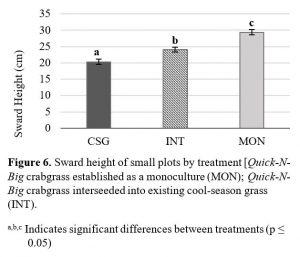
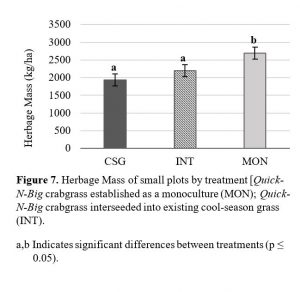
These differences were primarily attributable to the first grazing event in late July, where yield in MON (3,396 ± 245 kg/ha) exceeded that of either INT (1,644 ± 245 kg/ha) or CSG (1,844 ± 245 kg/ha; p ≤ 0.05; Figure 8). The yield of MON subsequently decreased at the second grazing event (2,123 ± 245 kg/ha) and did not differ from the HM measured in INT or CSG plots. These results suggest that the full productive potential of the warm-season CRB during the “summer slump” can only be attained when utilizing a monoculture establishment. Therefore, the integrated approach utilized in the full pastures for this study may have merit over interseeding CRB into an existing CSG stand, as the yield in the INT plots did not exceed that of the CSG. However, SH was greater in INT than CSG. Furthermore, when comparing MON vs. INT, it is important to note that measurements were only collected on the plots over the “summer slump” period when CRB was available for grazing. Over a full grazing season, an interseeded stand would offer the advantage of forage availability in the spring/early summer and later in the fall, whereas under monoculture establishment, such areas would be non-productive during these times. Furthermore, this study only evaluated one year of growth under grazing pressure. The INT plots had the greatest prevalence of planted grasses, while weeds, dead matter, and bare ground were more common in CSG and MON, which indicates that the INT establishment approach may promote stand persistence.
Works Cited:
Aiken, G.E. and D.W. Williams. 2015. Forage Yield and Nutritive Value of Turf Bermudagrasses Managed to Simulate a Horse Pasture Management Scheme in the US Upper Transition Zone. Crop Forag. Turf. Manag., 1.1:1-5
Baxter-Potter, W.R. and M.W. Gilliland. 1988. Bacterial pollution in runoff from agricultural lands. J. Environ. Qual. 17.1:27-34.
Bott, R.C., E.A. Greene, K. Koch, K.L. Martinson, P.D. Siciliano, C. Williams, N.L. Trottier, A. Burk, and A. Swinker. 2013. Production and environmental implications of equine grazing. J. Equine Vet. Sci. 33:1031-1043.
Butler, D.M., N.N. Ranells, D.H. Franklin, M.H. Poore, and J.T. Green. 2007. Ground cover impacts on nitrogen export from manured riparian pasture. J. Environ. Qual. 36.1:155-162.
Burk, A. O., N. M. Fiorellino, T. A. Shellem, M. E. Dwyer, L. R. Vough, and E. Dengler. 2011. Field Observations from the University of Maryland's Equine Rotational Grazing Demonstration Site: A Two Year Perspective. J. Equine Vet. Sci. 31:302-303 (Abstr.).
Chatterton, N.J., P.A. Harrison, J.H. Bennett, and K.H. Asay. 1989. Carbohydrate partitioning in 185 accessions of Gramineae grown under warm and cool temperatures. J. Plant Physiol. 134.2:169-179.
Crider, F.J. 1955. Root-growth stoppage resulting from defoliation of grass. USDA Tech. Bull. 1102:22.
Daly, C., M.P. Widrlechner, M.D. Halbleib, J.I. Smith, and W.P. Gibson. 2012. Development of a new USDA plant hardiness zone map for the United States. J. Appl. Meteor. Climatol. 51.2:242-264.
Ditsch, D.C., S.R. Smith, and G.D. Lacefield. 2011. Bermudagrass: A Summer Forage in Kentucky. Publication# AGR-48. University of Kentucky College of Agriculture, Lexington, KY, 40546
Evans, R. A., and R. M. Love. 1956. The step-point method of sampling-a practical tool in range research. J. Range Manage. 9:208-212.
Frank, N., R.J. Geor, S.R. Bailey, A.E. Durham, and P.J. Johnson. 2010. Equine metabolic syndrome. Journal of veterinary internal medicine, 24(3):467-475.
Gelly, C., Nave, R.L.G, and G. Bates. 2016. Forage Nutritive Value and Herbage Mass Relationship of Four Warm-Season Grasses. Agron. J. 108.4:1603-1613.
Giles, S.L., S.A. Rands, C.J. Nicol, and P.A. Harris. 2014. Obesity prevalence and associated risk factors in outdoor living domestic horses and ponies. PeerJ, 2:299.
Goer, R.J. and P.A. Harris. 2013b. Obesity. In: R.J. Goer, P.A. Harris, and M. Coenen, editors, Equine applied and clinical nutrition. Elsevier Ltd, U.K. p. 469-486.
Grev, A.M., Shaeffer, C.C., M.L. DeBoer, D.N. Catalano, and K.L. Martinson. Preference, Yield, and Forage Nutritive Value of Annual Grasses under Horse Grazing. 2017. Agron. J. 109.4:1561-72.
Henneke, D. R., G. D Potter, J. L. Kreider, and B. F. Yeates. 1983. Relationship between condition score, physical measurement, and body fat percentage in mares. Equine Vet. J. 15:371-372.
Hudson, D.J., R.H. Leep, T.S. Dietz, A. Ragavendran, and A. Kravchenko. 2010. Integrated warm-and cool-season grass and legume pastures: I. Seasonal forage dynamics. Agron. J. 102.01: 303-309.
Jaqueth, A. 2018. Novel Uses of Turfgrasses for Equine Operations. Doctoral Dissertation, University of Maryland, College Park, MD.
Jordan, S. A., K. R. Pond, J. C. Burns, D. T. Barnett, and P. A. Evans. 1995. Voluntary intake and controlled grazing of horses. Proc. Am. Forage Grassl. Counc. p. 71-75.
Kallenbach, R.L., R.J. Crawford, M.D. Massie, M.S. Kerley, and N.J. Bailey. 2012. Integrating bermudagrass into tall fescue-based pasture systems for stocker cattle. J. Anim. Sci. 90.1:387-394.
Kenny LB. 2016. The effects of rotational and continuous grazing on horses, pasture condition, and soil properties [dissertation]. Rutgers University, New Brunswick, NJ.
Kenny, L. B., D. Ward, M. Robson, and C. A. Williams. 2018. Technical note: Comparing four techniques for estimating desired grass species composition in horse pastures. J. Anim. Sci. 96:2219-2225. doi: 10.1093/jas/sky111
Longland, A., and B. Byrd. 2006. Pasture nonstructural carbohydrates and equine laminitis. J. Nutr. 136:2099S–2102S.
Longland, A.C., Barfoot, C. and Harris, P.A., 2011. The effect of wearing a grazing muzzle vs not wearing a grazing muzzle on pasture dry matter intake by ponies. Journal of Equine Veterinary Science, 5(31), pp.282-283.
Martinson, K. L., M. S. Wells, and C. C. Sheaffer. 2015. Horse preference, forage yield and species persistence of twelve perennial cool-season grass mixtures under horse grazing. J. Equine Vet. Sci. 36:19-25 (In press.) doi: 10.1016/j.jevs.2015.10.003
McIntosh, B. 2007. Circadian and seasonal variation in pasture nonstructural carbohydrates and the response of grazing horses. PhD Diss. Virginia Polytechnic Inst. and State Univ., Blacksburg, VA.
McMeniman, N. P. 2000. Nutrition of grazing broodmares, their foals and young horses. Rural Ind. Res. Dev. Corp. Canberra, ACT, Aust.
Moore K.J., L.E. Moser, K.P. Vogel, S.S. Waller, B.E. Johnson, and J.F. Pedersen. 1991. Describing and quantifying growth stages of perennial forage grasses. Agron. J. 83.6:1073-7.
Moore, K.J., T.A. White, R.L. Hintz, P.K. Patrick, and E.C. Brummer. 2004. Sequential grazing of cool-and warm-season pastures. Agron. J. 96.4:1103-1111.
Parvage, M.M., B. Ulén, and H. Kirchmann. 2013. A survey of soil phosphorus (P) and nitrogen (N) in Swedish horse paddocks. Agric. Ecosyst. Environ. 178:1-9.
Rutgers Equine Science Center. 2007. The New Jersey equine industry 2007 economic impact. Rutgers New Jersey Agricultural Experiment Station. New Brunswick, NJ.
Rutgers University Office of the State Climatologist. 2020. Historical Monthly Station Data. http://climate.rutgers.edu/stateclim_v1/monthlydata/index.php?stn=286055&elem=pcpn (Accessed 24 February 2020).
Smith, D.G., Mayes, R.W., Hollands, T., Cuddeford, D., Yule, H.H., Ladrero, C.M. and Gillen, E., 2007. Validating the alkane pair technique to estimate dry matter intake in equids. The Journal of Agricultural Science, 145(3), pp.273-281.
Taliaferro, C.M., 2005, May. Breeding forage bermudagrass for the US Transition zone. In Proceedings 59th Southern Pasture and Forage Crop Improvement Conference, Philadelphia, MS. p. 11-13.
Teutsch, Chris. 2006. Warm-season annual grasses for summer forage. Publication 418-004. Communication and Marketing, College of Agriculture and Life Sciences, Virginia Polytechnic Institute and State University.
Teutsch, C.D., Fike, J.H. and Tilson, W.M., 2005. Yield, digestibility, and nutritive value of crabgrass as impacted by nitrogen fertilization rate and source. Agronomy journal, 97(6), pp.1640-1646.
Tracy, B. F., M. Maughan, N. Post, and D. B. Faulkner. 2010. Integrating annual and perennial warm-season grasses in a temperate grazing system. Crop Sci. 50(5): 2171-2177.
Westervelt, R. G., J. R. Stouffer, H. F. Hintz, and H. F. Schryver. 1976. Estimating fatness in horses and ponies. J. Anim. Sci. 43:781-785. doi:10.2134/jas1976.434781x.
Williams, C. A., L. B. Kenny, and A. O. Burk. 2019. Effects of grazing system, season, and forage carbohydrates on glucose and insulin dynamics of the grazing horse. J. Anim. Sci. 97:2541–2554. doi: 10.1093/jas/skz103.
This study demonstrated that implementing an integrated rotational grazing approach that incorporates the warm-season annual Quick-N-Big crabgrass offers production advantages when compared to a traditional cool-season grass rotational grazing system. Production variables including herbage mass, sward height, and carrying capacity were all greater in crabgrass vs. cool-season pasture sections during the critical “summer slump” period from mid-July to mid-September. Establishment method also impacted “summer slump” forage production, with monoculture establishment of Quick-N-Big resulting in greater herbage mass and sward height when compared to interseeding into existing cool-season grasses. However, further research is necessary to determine the areal proportions of cool-season grass and crabgrass within an integrated system that would optimize full-season pasture production. Additionally, a full-season analysis of monoculture vs. interseeded establishment would provide greater insight regarding the effect of establishment method on early- and late-season pasture production.
The integrated rotational grazing approach did not result in marked differences in forage nutritional composition or horse condition in comparison to the traditional cool-season control. During the “summer slump”, there was a trend for lower WSC in the crabgrass sections vs. the cool-season sections, and there was a season-long trend for lower NSC and WSC in the integrated system. However, other nutrient fractions such as digestible energy, protein, and fiber did not differ between systems. Horse condition metrics such as body weight, body condition score, and body fat did not vary by system. There were differences in horse condition between grazing periods, however, with horses in both systems gaining weight during early-season grazing of cool-season pasture forage and then maintaining condition throughout the remainder of the grazing season. These results demonstrate that the integrated grazing approach provided adequate nutrition for adult healthy horses. Furthermore, horses in the integrated system maintained their weight during the “summer slump” period despite ad libitum pasture access throughout, having no differences with their counterparts in the control system that spent over half of the “summer slump” receiving a maintenance hay diet due to limited availability of cool-season pasture grass. This suggests that the integrated rotational grazing strategy could possess utility in grazing management of overweight and obese horses
Education & Outreach Activities and Participation Summary
Participation Summary:
Several tours conducted at the Ryders Lane Best Management Practices Demonstration Horse Farm at Rutgers University in the fall of 2017 previewed the upcoming research funded through SARE. Tour groups included equine science students from Rowan College as well as international delegations from China. In addition, the research to be conducted over the 2018 grazing season was introduced during the NE-1441 Annual Meeting (webinar, 8-31-2017). The upcoming research was also highlighted in the Rutgers Equine Science Center Annual Report, which is available on the ESC website (http://esc.rutgers.edu/) and was distributed in print to stakeholders in the New Jersey equine industry.
This research project was previewed at the annual Rutgers Horse Management Seminar on February 11, 2018. Preliminary results were shared during the NE-1441 Annual Meeting on August 21, 2018, as well as at the Rutgers Equine Science Center Evening of Science and Celebration on November 9, 2018. Additional tours for university and public groups were also conducted at the Ryders Lane Farm throughout 2018 and 2019.
Preliminary results from 2019 were shared during the NE-1941 Annual Meeting in August 2019. The 2019 meeting was hosted by Rutgers, and in addition to sharing results of our study with regional Extension specialists, this meeting also featured an Equine Environmental Management Seminar (for educators and service providers) and a Wine and Equine Outreach Event (for the public - horse owners, producers, and other stakeholders) where this research was featured. This research was also highlighted in a presentation at the Mid-Atlantic Arabian Horse Association Fall Seminar in October 2019.
This research also formed the basis for two popular press articles published in the New Jersey Farmer in July and August 2019.
Results of related studies of metabolic responses of horses grazing within the integrated systems was published in an abstract submitted for the 2019 Equine Science Society Symposium and was presented orally in the Production and Management Section of that conference. These results were also shared with the greater public at the Rutgers Equine Science Center Evening of Science and Celebration in November 2019. Further work focused on glucose and insulin responses of horses rotating between cool- and warm-season grasses in integrated systems was presented at the Rutgers Horse Management Seminar in February 2020.
The results from these pasture production studies will be featured in a graduate student talk at the Mid-Atlantic Nutrition Conference in April 2020.
In the future, further promotion of this research will be conducted using the Rutgers Equine Science Center (ESC) as established vehicle for widespread dissemination of equine research conducted at Rutgers University. The ESC hosts several educational seminars each year and maintains a world-class website (http://esc.rutgers.edu/) and Facebook page with almost 2,000 followers (as of April 2017). Final results of this study will be presented and discussed at regular ESC-sponsored events including our annual Horse Management Seminar for horse and farm owners, which attracts over 100 participants each year; the Equine Science Update, which summarizes the Center’s recent research for the general public; Stakeholder Meetings, and monthly industry meetings. New Rutgers fact sheets will be published and posted on the NJAES publications page (http://njaes.rutgers.edu/pubs/) and the ESC website and Facebook page.
Scientific publications and presentations at scientific society meetings are also being planned. This material is appropriate for general academics in animal and plant science as well as veterinarians and would be appropriate in journals like The Journal of Animal Science, Journal of Equine Veterinary Science or The Veterinary Journal. The Equine Science Society Symposium, American Society of Animal Science, and Soil Health Conference are a few conferences where this material could be presented. There are also numerous university and regional student competitions including the Mid-Atlantic Nutrition Conference and the New Jersey Agriculture Experiment Station graduate student competition where this material will be presented.
The PI of this project is involved with a regional USDA project called NE-1941: Horses and the Environment. Following a successful 10-year run of the predecessor project NE-1441, NE-1941 is in its second year as a multi-state project, incorporating the best regionally available data about animal use, feed, manure storage and disposal, pasture/cropping management, soil and environmental quality, erosion control, and site characteristics to meet the goal of minimizing negative environmental impacts of equine operations on soil, water, and air quality. Participating states include NJ, VA, MA, SD, MD, MN, NC, FL and PA. NE-1941 provides a national format for disseminating the results of this study and full results of this study will be shared at the NE-1941 2020 Annual Meeting in Minneapolis, MN.
Project Outcomes
In New Jersey alone, there are 42,500 equine animals and 7,200 equine operations covering 176,000 acres of land (Rutgers Equine Science Center 2007). Results of this project have the potential to influence the pasture management decisions of many of these operators. From an environmental standpoint, continued development and promotion of best management practices in horse grazing serves to protect valuable resources, such as soil and water. From an economic perspective, teaching farm owners how to reduce costs through pasture best management practices can positively impact the financial sustainability of individual businesses, protecting the stability and viability of the entire industry.
Results of this project will provide much-needed data on forage yield, nutritional value, and production costs associated with integration of warm-season grasses into cool-season temperate pastures in the Northeast region. These results will shape future best management practices in equine grazing designed to improve economic and environmental sustainability of equine operations in New Jersey and beyond. Adopting this management practice could have real-world impact on horse producers, informing management decisions and enhancing the future sustainability of these operations. These results are also useful for other livestock producers (ex: beef cattle, sheep, etc.) interested in incorporating the warm-season test forages evaluated in this study.
Because final data analysis from this project has just been completed, only preliminary results from this research have been shared at the numerous outreach events conducted through Extension outlets (both print publications, on-line resources, and in-person programming) at Rutgers. These results will form the basis for 2020 outreach efforts. Thus, the above numbers reflect a small number of producers whose management practices have been impacted, but this is largely because we have had any scheduled outreach events since the data analysis/interpretation from this study was completed. However, as we begin to roll-out the full results of this study and focus future programming efforts on highlighting this work, we will track producer impacts through program surveys and expect to reach a large audience with these outreach and education efforts.
As pertains to the specifics research objectives of this project, much knowledge was gained regarding the viability of integrated cool- and warm-season grass rotational grazing approaches for horse pasture management. The annual grass Quick-N-Big crabgrass proved to be an easily implemented option that provided a high forage yield. Utilizing the perennial Wrangler bermudagrass proved more difficult. The final study for my Ph.D. dissertation will thus focus on crabgrass-based grazing strategy for managing overweight horses. Areas of additional research necessary to refine best management practice recommendations for integrated rotational grazing grazing strategies have been outlined in the research section of this report.
Beyond the specific research objectives, one of the biggest takeaways from this project was the strong interest that we received from horse owners and farm managers attending our events where this research was previewed. Based on these responses, we are encouraged by the desire demonstrated by these participants to seek and receive education regarding horse pasture management practices that are both economically and environmentally sustainable as well as promoting optimal horse nutrition and health.
In addition to the production-centered research focused on in this project, additional grant funding has been secured to expand on the impact of integrating warm season grasses in to cool-season rotational grazing system on equine metabolic and gastrointestinal health. The final segment of this project will evaluate a crabgrass based grazing approach in obese horses.
Finally, this project resulted in a collaboration with Rutgers Extension Agents who secured funding through the New Jersey Agricultural Experiment Station to conduct hay production trials in 2020 that will evaluate warm-season grasses for purposes of hay production in New Jersey.
Areas for future research were outlined in the Results and Discussion section of this report.
